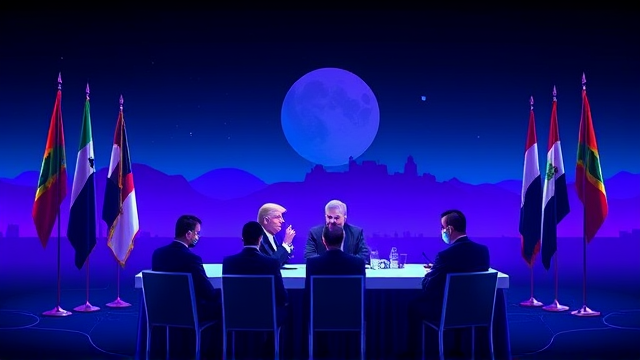Trump Signs Gaza Ceasefire Deal in Egypt
In a move that will undoubtedly be recorded by future historians as a pivotal moment in the long and tortured history of the Middle East, President Donald Trump, alongside a cadre of world leaders, has inked the first phase of a Gaza ceasefire deal in the Egyptian resort city of Sharm el-Sheik. This is not merely a fleeting pause in hostilities; it is a diplomatic gambit of Churchillian proportions, an attempt to impose a semblance of order upon a conflict that has, for generations, seemed intractably mired in ancient grievances and modern geopolitical machinations.The signing itself, held under the stark, watchful eye of the Sinai sun, carries the heavy weight of precedent. One cannot help but draw parallels to the Camp David Accords of 1978, where another American president, Jimmy Carter, mediated a fragile peace between Egypt and Israel, a framework that has held, however tenuously, for decades.The question now is whether this new agreement, forged in the shadow of unprecedented destruction in Gaza and a profound shift in global public opinion, possesses the structural integrity to survive the inevitable tests to come. The deal's first phase, as understood by analysts, ostensibly focuses on a permanent cessation of rocket fire from Hamas and a reciprocal halt to Israeli military operations, but the devil, as always, resides in the details not yet public—the mechanisms for monitoring, the timeline for the reconstruction of Gaza, the fraught issue of prisoner exchanges, and the long-deferred political horizon for a two-state solution.The presence of President Trump at the helm of these negotiations is itself a subject of intense scrutiny. His administration’s foreign policy has often been characterized by a disruptive, unilateralist streak, yet here we see a return to a more traditional, albeit high-stakes, form of shuttle diplomacy.Critics will argue that any deal bearing his signature is inherently unstable, while supporters will hail it as the bold, unpredictable masterstroke that only he could deliver. The involvement of Egypt, a perennial intermediary, signals a reassertion of its regional influence, while the quiet, yet crucial, backing from Gulf states suggests a realignment of Arab priorities, where the threat of Iran increasingly overshadows the historical solidarity with the Palestinian cause.The immediate consequences are clear: a desperately needed respite for the civilians of Gaza, who have endured a humanitarian catastrophe, and a reduction in the constant threat of attack for Israelis living in the south. But the long-term analytical outlook is far murkier.Does this agreement strengthen the Palestinian Authority at the expense of Hamas, or does it inadvertently legitimize the militant group by treating it as a sovereign negotiating partner? Will it lead to a renewed, U. S.-backed push for a comprehensive peace plan, or will it simply become another line in the sand, a temporary calm before the next, inevitable storm? The geopolitical chessboard has been reset, but the fundamental pieces—the settlements, the right of return, the status of Jerusalem—remain in play. The success of this ceasefire will not be measured in days or weeks of quiet, but in whether it can create the political space for the even more difficult conversations that must follow. As in the aftermath of great conflicts past, the signing of a document is merely the end of the beginning; the arduous task of building a lasting peace, a task that has eluded the best minds and strongest wills for over half a century, now begins anew under the watchful eyes of a weary world.
Latest News
In a decisive maneuver that sent immediate shockwaves through the geopolitical and technological landscape, the Dutch government has seized operational control
32 minutes ago0 comments
In a move that will be scrutinized by historians for its geopolitical weight, the United States President, alongside a cadre of world leaders, has formally
42 minutes ago2 comments
In a calculated diplomatic maneuver that speaks volumes through its silence, the Venezuelan government has shuttered its embassy in Oslo, a move coming just
47 minutes ago0 comments
In the grand theater of global diplomacy, where the specter of a trade war between the world's two preeminent economic powers looms large, the latest
57 minutes ago0 comments
The meticulously choreographed exchange of prisoners and hostages between Israel and Palestine, while a tangible de-escalation, represents not an endpoint but
1 hour ago0 comments
Japan has initiated a comprehensive review of foreign-owned land sales, a strategic move driven by escalating national security apprehensions that analysts
1 hour ago0 comments
The political theater outside Westminster Magistrates' Court unfolded with predictable precision Monday morning, as far-right organizer Tommy Robinson—real
2 hours ago0 comments
In a move that echoes the gravest moments of the Cold War, Britain’s domestic intelligence service, MI5, has issued a stark and unusually public warning to the
3 hours ago2 comments
It’s quiet here...Start the conversation by leaving the first comment.
